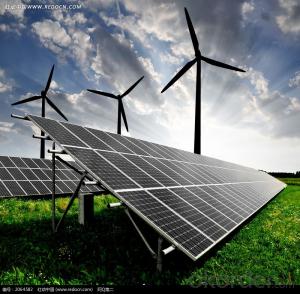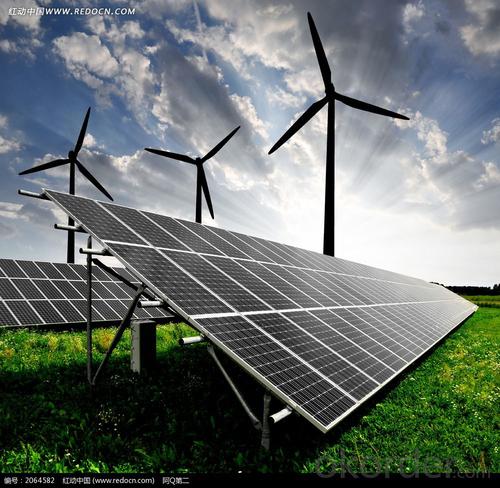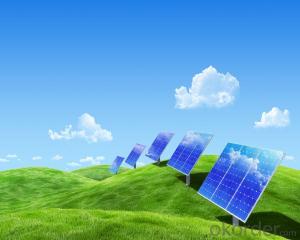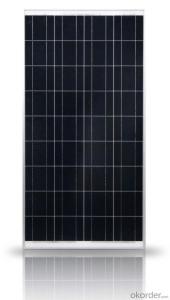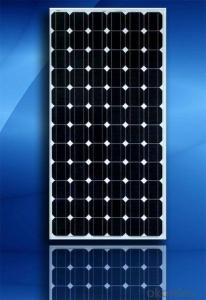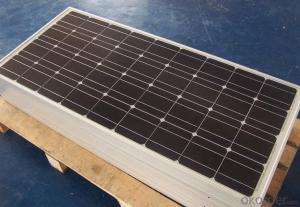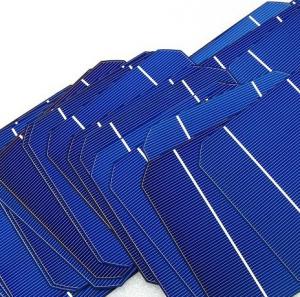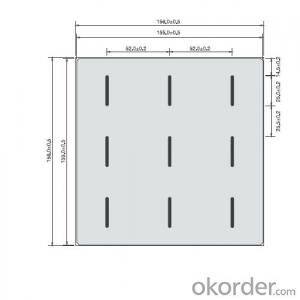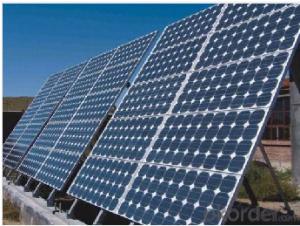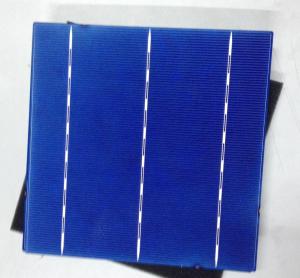Hot Carrier Solar Cells Poly Solar Panel with 25 Years Warranty for Hot Selling CNBM
- Loading Port:
- Qingdao
- Payment Terms:
- TT OR LC
- Min Order Qty:
- 10 set
- Supply Capability:
- 300000 set/month
OKorder Service Pledge
OKorder Financial Service
You Might Also Like
Polycrystalline Solar Modules
CNBM offers a range of small, medium and large polycrystalline solar modules, designed for a range of requirements.
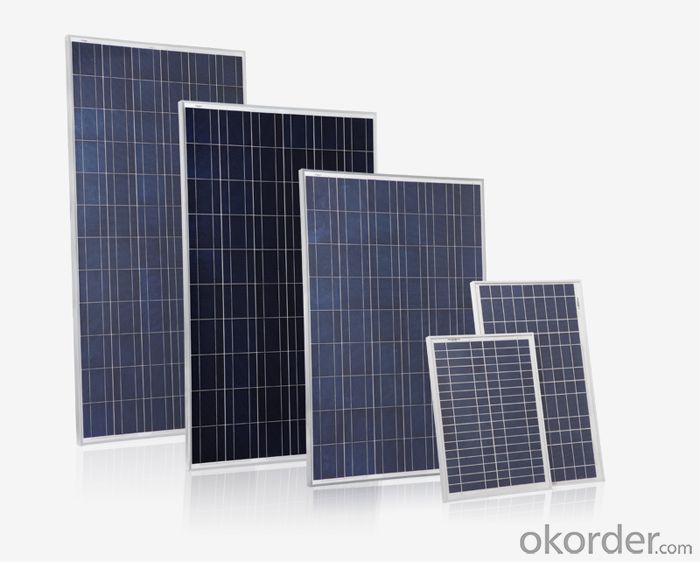

Specifications:
Tolerance | +/-3% |
Cell | Polycrystalline silicon solar cells (156 x 156mm) |
N0. of Cells | 60 (10 x 6) |
Dimension of Modules (mm) | 1650 x 990 x 40 |
Weight (kg) | 25.5 |
Limits:
Operating Temperature | -40~+85? |
Storage Temperature | -40~+85? |
Maximum System Voltage | 1000 VDC max. |
Hail Impact | Diameter of 28mm with impact speed |
Temperature and Coefficients:
NOCT | 48C+/-2? |
Voltage temperature coefficient (%/K) | -0.35 |
Current temperature coefficient (%/K) | 0.05 |
Power temperature coefficient (%/K) | -0.45 |
Characteristics:
Model: | SGM-200P | SGM-210P | SGM-220P |
Max-power voltage Vmp (V) | 29.2 | 29.4 | 29.41 |
Max-power current Imp (A) | 6.85 | 7.14 | 7.48 |
Open-circuit voltage Voc (V) | 36.5 | 36.69 | 36.9 |
Short-Circuit Current Isc (A) | 7.28 | 7.6 | 7.93 |
Max-power Pm(W) | 200 | 210 | 220 |
Model: | SGM-230P |
Max-power voltage Vmp (V) | 29.8 |
Max-power current Imp (A) | 7.72 |
Open-circuit voltage Voc (V) | 37.31 |
Short-Circuit Current Isc (A) | 8.19 |
Max-power Pm(W) | 230 |
STC: Irradiance 1000W/m2, module temperature 25?, AM-=1.5
Poly Crystalline Solar Panels Specifications Range
Maximum Power (Pm) | Dimension | Weight | Operating Voltage (Vmp) | Operating Current (Imp) | Open Circuit Voltage (Voc) | Short Circuit Current (Isc) |
0.45W | 140x80x10mm | 0.08kg | 3.3V | 150mA | 4.6V | 160mA |
1.0W | 162x140x10mm | 0.16kg | 7.5V | 150mA | 10.3V | 160mA |
4.5W | 269x251x23mm | 0.8kg | 16.5V | 0.27A | 20.5V | 0.3A |
10W | 420.1×268.9×22.6mm | 1.92kg | 17.5V | 0.58A | 20.5V | 0.6A |
20W | 425x502x50mm | 3.0kg | 16.8V | 1.19A | 21.0V | 1.29A |
30W | 593x502x22.6mm | 3.9kg | 16.8V | 1.78A | 21.0V | 1.94A |
40W | 655x537x50mm | 5.75kg | 17.3V | 2.31A | 22.1V | 2.54A |
50W | 839x537x50mm | 6.0kg | 17.5V | 2.9A | 21.8V | 3.17A |
65W | 1111x502x50mm | 7.2kg | 17.6V | 3.69A | 22.1V | 3.99A |
80W | 1204x537x50mm | 7.7kg | 17.6V | 4.55A | 22.1V | 4.8A |
- Q: How do solar cells impact water resources?
- Solar cells do not directly impact water resources as they generate electricity from sunlight, which does not require water. However, the production and manufacturing processes of solar cells may require water, but it is relatively minimal compared to other forms of energy generation like fossil fuels or nuclear power.
- Q: On the parallel connection of solar cells
- Whether you say more than one solar cell is in series or parallel, it depends on your use requirements to decide if the parameters of solar cells are basically the same, and you need a relatively high "use" voltage, that can The battery in series, if you need a larger operating current and the voltage does not need high, you can connect multiple solar cells in parallel to get a higher output current;
- Q: How do solar cells perform in extreme weather conditions?
- Solar cells can generally perform well in extreme weather conditions. However, extreme heat can cause a slight decrease in their efficiency, while extreme cold temperatures can reduce the power output temporarily. Additionally, severe weather events such as hailstorms or strong winds may damage the solar panels if they are not properly installed or protected. Nonetheless, solar cells are designed to withstand these conditions and continue to generate electricity, making them a reliable and sustainable energy source even in extreme weather.
- Q: How do solar cells perform in regions with high levels of humidity and rainfall?
- Solar cells generally perform well in regions with high levels of humidity and rainfall. While moisture in the air can reduce the efficiency of solar cells to some extent, modern solar panels are designed to withstand these conditions. Additionally, rain can actually help clean the panels, removing dust and dirt that may accumulate over time. Overall, solar cells can still generate a significant amount of electricity in regions with high humidity and rainfall.
- Q: Can solar cells be used in public charging stations for electric vehicles?
- Yes, solar cells can be used in public charging stations for electric vehicles. Solar panels can generate electricity from sunlight and convert it into usable energy to charge electric vehicles, making them a sustainable and environmentally-friendly option for public charging infrastructure.
- Q: What is the environmental impact of solar cell production?
- The environmental impact of solar cell production is relatively low compared to other forms of energy production. The manufacturing process of solar cells does generate some greenhouse gas emissions and other pollutants, but these emissions are significantly lower compared to traditional fossil fuel-based energy sources. Additionally, the use of solar energy helps reduce carbon dioxide emissions and dependence on fossil fuels, thereby mitigating climate change and promoting a cleaner and more sustainable future.
- Q: What is the impact of solar cells on reducing energy inequality?
- Solar cells have a significant impact on reducing energy inequality by providing access to clean and affordable electricity for communities that are underserved or lack access to traditional power sources. By harnessing the abundant and renewable energy from the sun, solar cells facilitate the decentralization of energy production, enabling individuals and communities to generate their own power and reduce their dependence on centralized grids. This empowers marginalized communities to become energy self-sufficient, bridging the energy gap and promoting a more equitable distribution of energy resources. Additionally, solar cells contribute to mitigating climate change and reducing carbon emissions, which disproportionately affect vulnerable populations, further addressing energy inequality and promoting sustainable development.
- Q: How are solar cells used in military applications?
- Solar cells are used in military applications to power various equipment and devices in the field, such as communication systems, surveillance equipment, and remote sensors. They provide a reliable and sustainable source of energy, reducing the need for traditional fuel-based generators and minimizing logistical challenges. Additionally, solar cells can be integrated into portable and lightweight systems, enabling soldiers to operate efficiently in remote areas or during extended missions.
- Q: Do solar cells work at night or in low light conditions?
- Solar cells do not work at night as they require sunlight to generate electricity. In low light conditions, their efficiency decreases significantly, but they can still produce some electricity, although at a much lower rate.
- Q: Can solar cells be used for powering agricultural irrigation systems?
- Yes, solar cells can be used for powering agricultural irrigation systems. Solar-powered irrigation systems use photovoltaic cells to convert sunlight into electricity, which can then be used to power pumps and other equipment needed for irrigation. This sustainable and renewable energy source is particularly beneficial for remote areas with limited access to electricity grids.
Send your message to us
Hot Carrier Solar Cells Poly Solar Panel with 25 Years Warranty for Hot Selling CNBM
- Loading Port:
- Qingdao
- Payment Terms:
- TT OR LC
- Min Order Qty:
- 10 set
- Supply Capability:
- 300000 set/month
OKorder Service Pledge
OKorder Financial Service
Similar products
Hot products
Hot Searches
Related keywords
